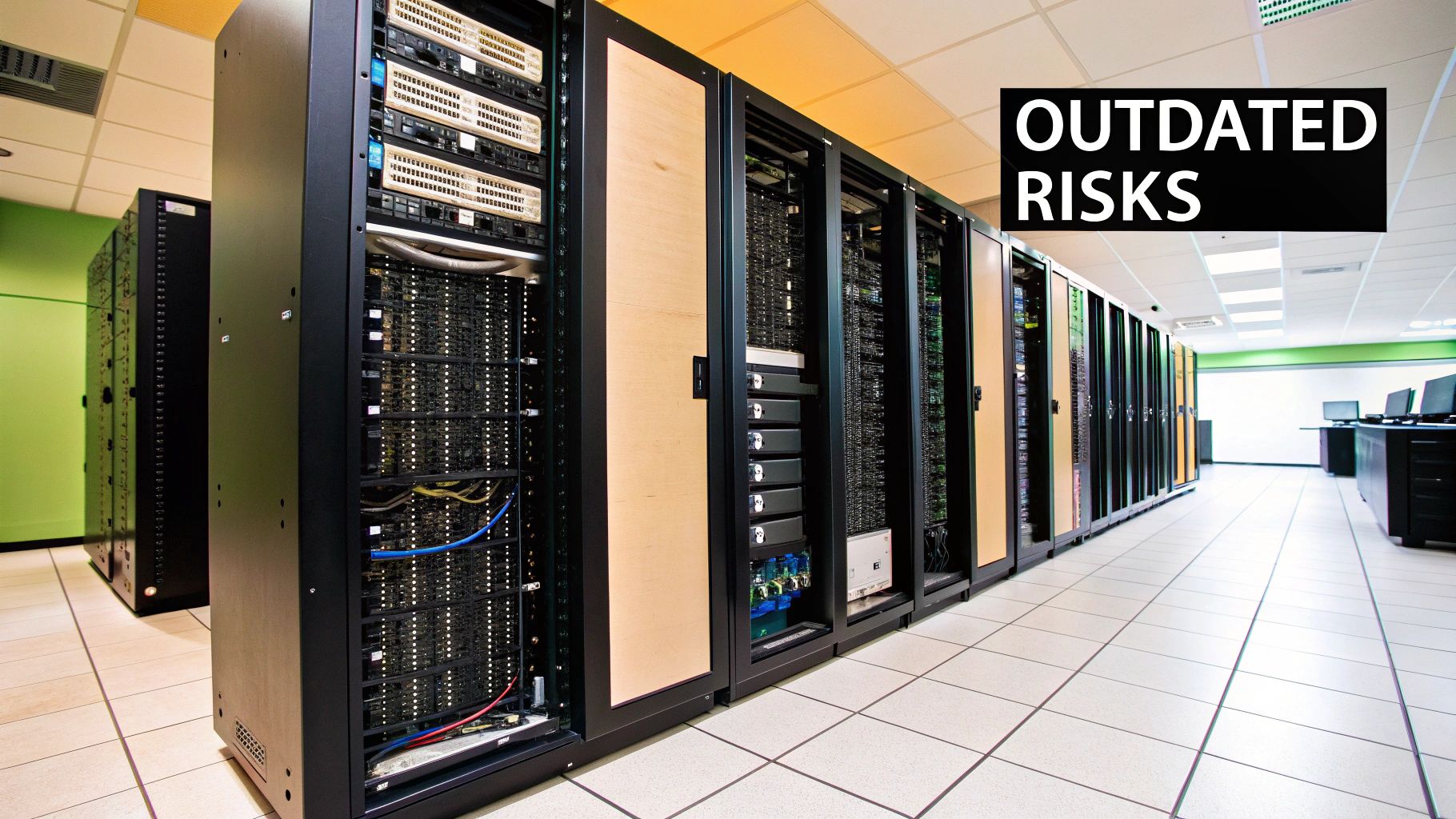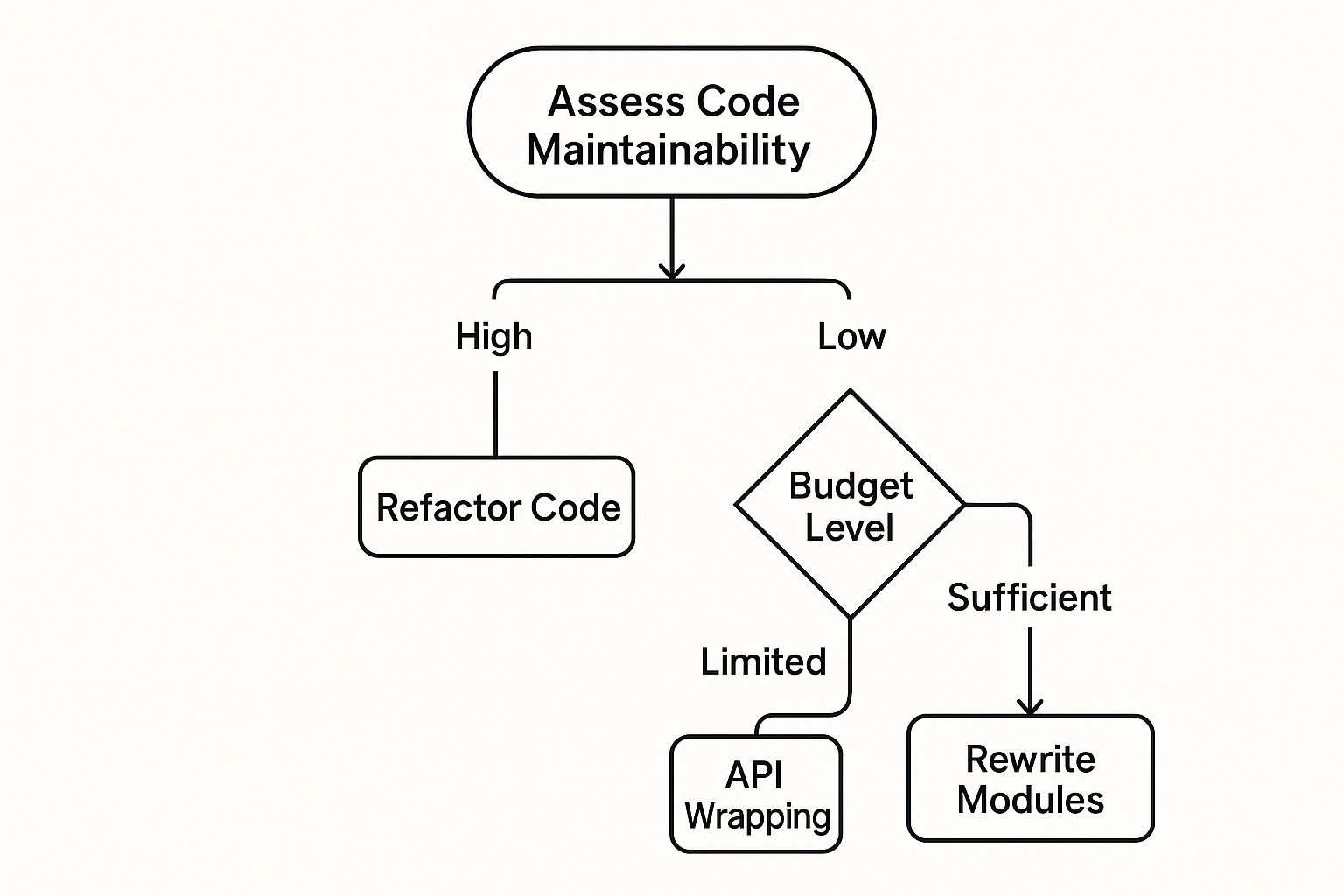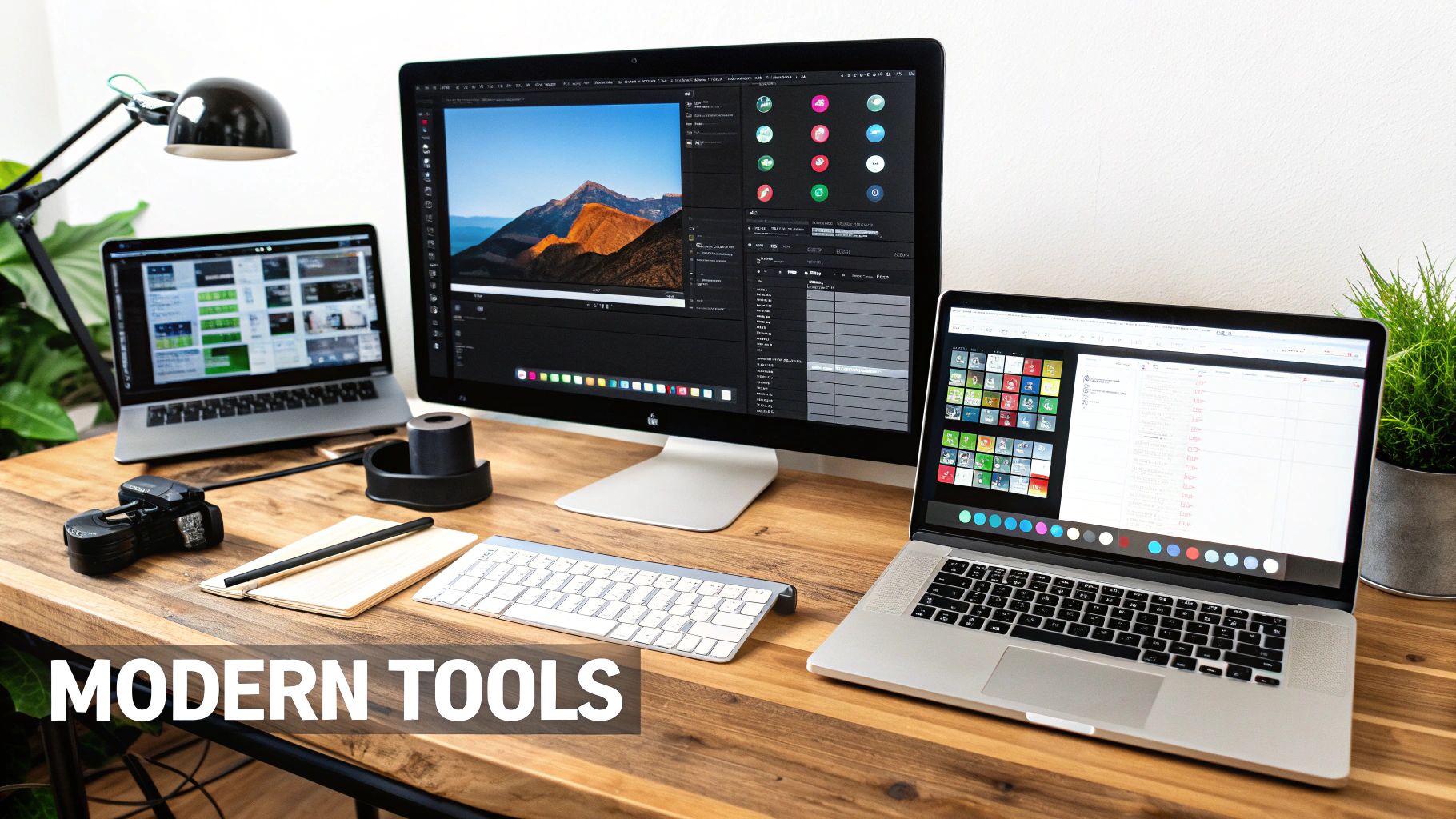When we talk about modernizing legacy systems, what we're really discussing is a fundamental shift in how your business operates. It’s about taking those old, yet critical, pieces of software and updating or replacing them to boost performance, tighten up security, and give your teams the agility they need.
Think of it less as a simple tech upgrade and more as a strategic decision to get your technology in lockstep with where your business is headed today. Sticking with outdated systems isn't just about keeping the lights on; it's about actively accepting risks and costs that only grow over time.
Why Modernization Has Become a Business Imperative
Running a business on outdated technology is like trying to compete in a Formula 1 race with a Model T. Sure, it might still run, but you're not going to win. The old "if it ain't broke, don't fix it" philosophy is a dangerous trap in the world of enterprise IT.
It's a surprisingly common problem. A recent survey revealed that by 2025, a staggering 62% of U.S. organizations will still be relying on legacy software. The reason? Half of them admit it's simply because the old systems still function. This perspective completely ignores the silent killers: technical debt and missed opportunities. You can dig into the full details in this legacy software modernization survey from Saritasa.com.
These creaky old systems are a major source of friction. They’re a nightmare to integrate with modern tools, they actively stifle innovation, and they leave you wide open to security vulnerabilities that were patched ages ago on newer platforms.
The Hidden Costs of Doing Nothing
The real price of keeping legacy systems isn't found in the maintenance line item on your budget. It’s measured in all the things you can't do—the lost opportunities, the clunky workflows, and the increasingly high price of finding developers who even remember how to work with obsolete code.
Every day you wait, you're just piling on more technical debt. This makes the eventual modernization project exponentially more complex and expensive.
Beyond that, these systems bleed money from your bottom line in very real ways:
- Sky-High Maintenance Fees: Supporting ancient hardware and niche software often demands specialized (and very expensive) expertise.
- Operational Drag: Slow, cumbersome processes don't just waste employee time; they frustrate your customers and create a poor experience.
- Glaring Security Risks: Unpatched and unsupported systems are basically an open invitation for cyberattacks, which can lead to catastrophic data breaches and a tarnished reputation.
Modernization isn't just a defensive move to avoid disaster. It's about unlocking the potential that's trapped in your old tech. When you update your core systems, you give your entire business the power to be more agile and competitive in a market that never slows down.
Legacy vs. Modernized Systems A Quick Comparison
The contrast between operating on legacy infrastructure versus a modern platform is night and day. One anchors you to the past, while the other launches you into the future. Understanding this difference is key for any leader looking into how to reduce operational costs and boost the overall health of the business.
Here’s a simple breakdown of what that shift looks like in practice.
| Attribute | Legacy System Environment | Modernized System Environment |
|---|---|---|
| Agility | Slow to change; new features take months or years. | Rapid deployment of new features and updates. |
| Security | Often unsupported with known vulnerabilities. | Proactive security with regular patches and updates. |
| Integration | Difficult and expensive to connect with new tools. | Seamless API-based integration with other platforms. |
| User Experience | Clunky, outdated interfaces that frustrate users. | Intuitive, modern interfaces that boost productivity. |
| Scalability | Limited; cannot handle sudden growth easily. | Elastic scalability to meet changing demands. |
As you can see, the benefits go far beyond just having newer technology. A modernized environment fundamentally changes what your business is capable of achieving.
How to Assess Your Technology Landscape

Before you can even think about modernizing, you have to get an honest, unvarnished look at what you’re actually running. A deep-dive audit isn’t just about ticking off a list of servers and software versions; it's about figuring out how your current technology truly supports—or more often, holds back—your business.
This is the phase where you untangle the web of dependencies, expose all those hidden costs, and pinpoint the real sources of frustration. If you skip this, you’re essentially flying blind. You might pour money into the wrong initiative or, even worse, accidentally break a critical business process you didn’t even know was connected.
Cataloging Your Current Systems
First things first, you need to create a complete inventory of every single application, piece of software, and bit of hardware in your ecosystem. Don't just stop at the name and age. The goal here is to build a detailed profile for each asset that shows its actual role and impact on the organization.
As part of this initial sweep, it’s a good idea to conduct comprehensive network security assessments. This process often uncovers serious vulnerabilities that have been lurking in outdated networks for years and gives you a solid security baseline to build upon.
This exercise often reveals just how much technical debt a company is carrying. It’s not a small number. In 2022, the collective technical debt for U.S. companies was estimated to be a staggering $1.52 trillion. This shows the real financial drag of keeping old systems on life support. The problem is especially bad in sectors like healthcare, where over 60% of hospitals are still relying on ancient software to function.
Evaluating Business Value and Technical Health
With your inventory complete, it's time to evaluate each system on two critical fronts: its value to the business and its technical condition. This isn't a simple "good" or "bad" sticker. It demands frank conversations between the people who use the software every day and the IT teams who have to keep it running.
A simple quadrant model is a fantastic tool for this. You can plot every application to get a clear visual of your priorities:
- High Business Value, Good Technical Health: These are your champions. Keep them healthy and invest in their future.
- High Business Value, Poor Technical Health: These are your top modernization targets. They're essential but are built on a shaky foundation.
- Low Business Value, Good Technical Health: Can this tech be repurposed? Or is it just a low-priority system that quietly does its job?
- Low Business Value, Poor Technical Health: These are the obvious candidates for retirement. Get them on the chopping block.
By plotting your systems this way, you move from a confusing list of assets to a strategic map. This visual clarity is essential for getting stakeholder buy-in and focusing your modernization efforts where they will deliver the most significant impact.
This detailed assessment arms you with the hard data you need to make smart, defensible decisions. It turns the fuzzy, overwhelming challenge of modernizing legacy systems into a clear, prioritized action plan. This audit isn't just a preliminary step; it’s the bedrock of your entire strategy.
Choosing the Right Modernization Strategy
Picking the right path to modernize an old system isn't about chasing the latest tech trend. It's a calculated business decision. A strategy that works wonders for one company could spell disaster for another, so the goal is to align your technical approach with very specific business goals.
The whole modernization field is often boiled down to the "7 Rs"—a menu of strategies from simple migrations to complete overhauls. Each one comes with its own price tag, risk level, and potential for business impact. To get a real feel for these options, exploring some different legacy system modernization strategies is a great place to start.
Knowing what’s possible is the first step toward making a smart, cost-effective choice.
Decoding the 7 Rs of Modernization
Let's break down what these seven core strategies actually mean in practice. Think of them as a spectrum, moving from the least disruptive to the most intensive.
- Rehost (Lift-and-Shift): This is the path of least resistance. You’re essentially picking up your application from an on-premise server and dropping it into a cloud environment with almost no code changes. It’s fast, low-risk, and perfect for quick wins, like when you need to get out of a data center lease—fast.
- Replatform (Lift-and-Reshape): This is a step up from a simple rehost. Here, you make a few small tweaks to the application to take advantage of cloud-native features, like swapping out an old database for a managed service. It delivers more benefits than a lift-and-shift without requiring a massive rewrite.
- Refactor: This one is all about cleaning up your house. You dive into the existing code to restructure and optimize it, improving performance and making it easier to maintain. The key here is that the application’s external behavior doesn't change. It's a fantastic way to tackle technical debt in a system that’s still fundamentally doing its job.
These first three are often your best bet for seeing some quick ROI. But for systems with problems that run deeper, you’ll need to consider more serious interventions.
Advanced Strategies for Deeper Transformation
When small adjustments just won't do the trick, it's time to think about more fundamental changes. These next approaches require a bigger investment, but the long-term payoff can be huge.
- Rearchitect: This involves significantly changing the application's architecture. A common example is breaking down a clunky monolithic application into a more nimble collection of microservices. This is the go-to strategy when you need to make an old system more scalable and agile for the future.
- Rebuild (Rewrite): With this one, you're starting from scratch. You take the original scope and specifications of the application but rebuild it entirely using modern tools and code. This is your best option when the business logic is still solid, but the technology it was built on is completely obsolete.
- Replace: Sometimes, the smartest move is to just throw the old system out. You can replace it entirely with a new solution, which is often a commercial SaaS product. This makes perfect sense when a third-party tool can meet your business needs better, faster, and cheaper than a custom-built app.
- Retain: Finally, don't underestimate the power of doing nothing. If a legacy system is stable, cheap to maintain, and isn't holding the business back, you might just keep it. This isn't laziness; it's smart resource allocation. Focus your budget and team on the problems that actually need solving.
The decision isn't just about technology—it’s a strategic business choice. The "best" approach is the one that directly addresses your biggest pain points, aligns with your budget, and fits your organization's tolerance for risk.
This decision tree gives a simple visual for how to think through the process based on your code's health and your budget.

As the visual suggests, the health of the asset is your starting point, which then guides budget-driven decisions. Getting this initial evaluation right is everything. You can sharpen your assessment skills by reviewing some IT asset management best practices.
Modernization Strategy Decision Matrix
To help you weigh your options, this matrix compares the "7 Rs" across key factors. It’s a high-level guide to help you frame your thinking and see the trade-offs at a glance.
| Strategy | Description | Typical Cost | Implementation Speed | Level of Risk |
|---|---|---|---|---|
| Rehost | Move the application to the cloud with minimal or no code changes. | Low | Very Fast | Low |
| Replatform | Move to the cloud with minor optimizations for cloud-native features. | Low-Medium | Fast | Low |
| Refactor | Restructure existing code to improve maintainability without changing function. | Medium | Medium | Low-Medium |
| Rearchitect | Materially alter the architecture, e.g., move from monolith to microservices. | High | Slow | High |
| Rebuild | Recreate the application from scratch using modern technology. | Very High | Very Slow | Very High |
| Replace | Discard the old system and switch to a third-party (often SaaS) solution. | Varies | Fast | Medium |
| Retain | Make no changes and continue using the system as-is. | Very Low | N/A | Low |
Remember, this is a starting point. Your real-world costs and risks will depend entirely on the specifics of your system and your team's capabilities. Use this to guide your initial conversations and narrow down the most viable paths for your organization.
Building Your Modernization Roadmap and Business Case

Alright, you've settled on a modernization strategy. Now comes the hard part: turning that big-picture vision into a concrete plan that people can actually follow. This means building a phased roadmap—a detailed timeline that shows exactly what you’re doing, how you’re doing it, and when.
The trick is to start small. Your first move should be a low-risk, high-impact project that delivers a tangible win, fast.
Scoring an early victory is everything. It builds momentum, shows everyone what's possible, and starts winning over the skeptics in the room. Pick something that’s visible enough for people to notice but not so critical that a small hiccup brings the whole company to a halt. This approach proves the concept and builds the confidence needed for the tougher, more complex work ahead.
Crafting a Persuasive Business Case
Getting executives on board isn't about geeking out on technical details. It's about speaking their language: business outcomes. Your business case needs to tell a compelling story that ties the entire modernization effort directly to the company's financial health.
Your argument should stand on three solid pillars:
- Cost Savings: Don't just say you'll save money—show them the numbers. Quantify savings from shutting down old servers, ending expensive maintenance contracts, and cutting operational overhead.
- Risk Mitigation: This is about highlighting the cost of doing nothing. Talk about potential fines for non-compliance, the financial damage from a security breach, or the revenue you'd lose during a system outage.
- New Revenue Opportunities: Explain how a modern system opens doors. Will it let you launch products faster? Create a better customer experience? Break into a new market? Spell it out.
The cost of inaction is real. Just keeping the lights on for old infrastructure is a huge expense; some enterprises spend around $40,000 annually per legacy system. But the true danger is catastrophic failure. Look at what happened with HSBC's 2025 banking outage or when United Airlines had to ground over 1,000 flights because of a legacy system glitch. You can find more examples of these legacy application modernization trends on Techolution.com.
Presenting Your Plan for Maximum Impact
When you walk into that boardroom, focus on the "why" and the "what," not just the "how." The C-suite doesn't really care about your brilliant plan to adopt microservices. They care about how that plan will help them capture 10% more market share over the next two years.
A successful business case doesn't sell technology; it sells a business outcome. Frame every technical decision as a solution to a specific business problem, whether it's cutting costs, reducing risk, or accelerating growth. This transforms your pitch from an IT expense into a strategic investment.
Use clean visuals, straightforward language, and data to back up every claim. Your objective is to make approving your project feel like the only logical choice for the future of the business. When you connect your technical roadmap to clear financial wins, you give executives the justification they need to not just sign off, but to become your biggest advocates.
Executing the Project and Managing Change

Alright, this is where theory ends and reality begins. All the meticulous planning in the world won't matter if the execution falters. I've seen it happen time and again: a modernization project that looks perfect on paper collapses under the weight of poor execution and a complete disregard for the human element.
Let's be blunt. Too many of these initiatives fail not because the new technology was flawed, but because the organization simply wasn’t prepared for the change. A staggering 74% of modernization projects never even cross the finish line, and a huge chunk of that comes down to a breakdown during this phase. If you want to avoid becoming another statistic, you have to shift your focus to minimizing disruption while getting everyone on board.
This is where agile principles become your best friend. Forget the old-school "big bang" launch where you disappear for a year and then unveil a new system to a bewildered workforce. Instead, break the project into smaller, manageable sprints. This lets your team deliver tangible value in short bursts, gather feedback, and pivot when needed without sinking the entire ship.
Assembling Your Modernization Team
Your project's success is directly tied to the people you put on the team. This isn't just an IT job; it's a business transformation. You need a cross-functional group with a mix of perspectives to ensure the new system actually works for the people who will be using it every day.
So, who needs a seat at the table?
- Business Stakeholders: These are the people who live and breathe the daily operations. They’re your champions who can articulate the project's real-world business value.
- Technical Experts: Your developers, engineers, and data specialists. They’ll handle the nitty-gritty of migration, integration, and building the new platform.
- Project Managers: The conductor of the orchestra. They keep the project on track, manage resources, and ensure everyone is communicating clearly.
- End-User Representatives: This is non-negotiable. You need people who will actually use the new system to provide invaluable, real-world feedback from the trenches.
If you look around and realize you have some gaps—especially around tricky cloud migrations or ongoing system maintenance—don't be afraid to bring in outside help. Partnering with a provider of managed IT services can be a smart move, freeing up your internal team to focus on the business logic while experts handle the technical heavy lifting.
Navigating Change and Driving Adoption
Here’s the part everyone underestimates: the human side. People are creatures of habit. They're comfortable with the old, clunky system because they know it. A new system, no matter how much better it is, feels disruptive and can even be seen as a threat. Solid change management is the only way to turn that natural resistance into enthusiastic adoption.
It all starts with communication. Be transparent from day one. Explain why you're making this change, but frame it around how it will make their jobs easier, not just how it helps the company's bottom line.
A new system that no one uses is a failure, no matter how technically brilliant it is. True success is measured by adoption. Prioritize user training, create accessible support channels, and actively celebrate small wins to build positive momentum throughout the transition.
You also need to give people a voice. Set up clear feedback loops—like regular check-ins or a dedicated Slack channel—so users feel heard. When people see their suggestions being taken seriously and implemented, they shift from being passive recipients of change to active partners in finding the best solution.
Answering the Tough Questions About Legacy Modernization
Even with the best-laid plans, modernizing an old system always stirs up some tough questions. It's a massive undertaking, and it’s natural for leaders and technical teams to have concerns. Let's tackle some of the most common ones I hear. Getting these answers straight from the beginning can save you a world of hurt later on.
These aren't just technical queries; they often get to the heart of the business case for modernization. Answering them well gets everyone, from the engineering team to the C-suite, on the same page.
Where On Earth Do We Start? Deciding Which System Goes First
This is the big one. You can't boil the ocean, so prioritization is key. My advice? Look for the intersection of high business value and high technical risk. Your prime candidate is often a system that your business simply cannot function without, but is also a nightmare to maintain, costs a fortune, or is riddled with security holes. Tackling this first solves your biggest, most immediate problem.
But there's another way to play it. Sometimes, the best first move is to pick a lower-risk system that has high visibility across the company. Nailing a quick, visible win can build a massive amount of momentum. It makes getting the budget and support for the much tougher projects down the road a whole lot easier.
To take the guesswork out of it, I always recommend a simple scoring matrix. Rank your systems based on a few critical factors:
- Business Impact: How badly does it hurt if this system goes down? Is it directly tied to revenue?
- Operational Cost: What’s the real annual cost? Think maintenance contracts, licensing fees, and the staff hours spent just keeping it alive.
- Security Risk: Are there known vulnerabilities? Is it a compliance nightmare waiting to happen?
- Modernization Difficulty: Let's be honest, how hard will this be to actually update or replace?
Using data like this strips the emotion and politics out of the decision. It gives you a clear, logical starting point for the entire initiative.
What's the Single Biggest Mistake People Make?
I've seen this one sink more projects than any other: treating modernization as just an IT project. When the tech team goes off into a corner to build the "perfect" new system without talking to the people who actually use it every day, the result is almost always a disaster.
This kind of disconnect is poison. You end up with a technically impressive system that nobody wants to use because it doesn't solve their real-world problems. The adoption rates are terrible, and all that time and money goes right down the drain.
The projects that succeed are the ones run as a true partnership. It’s not a handoff from the business to IT; it's a constant conversation. The goal has to be tied to a real business outcome, not just checking off a list of technical features.
Do We Really Have to Rewrite Everything from Scratch?
No, and you probably shouldn't! A full "rip and replace" is often the most expensive, disruptive, and riskiest path you can take. It’s a last resort, really only suitable for systems where the core business rules are still gold, but the technology it’s built on is completely obsolete.
There are much smarter, less painful ways to get this done. Many successful projects rely on incremental steps that deliver value much faster. For example:
- Rehosting: This is the classic "lift-and-shift." You move the application, largely as-is, to a modern cloud environment. It's a quick win for getting out of an old data center.
- Refactoring: Here, you're not changing what the application does on the outside, but you're cleaning up the internal code. This is fantastic for chipping away at technical debt and making the system easier to maintain.
These approaches get you results sooner and with far less risk than a multi-year, big-bang rewrite.
At Clouddle Inc, we've guided countless businesses through these exact challenges. Our expertise is in crafting a modernization strategy that fits your reality—your budget, your people, and your goals. We handle the technology so you can stay focused on what you do best: growing your business. Discover our managed IT and cloud solutions.


